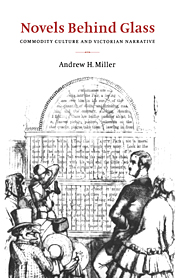Book contents
- Frontmatter
- Contents
- List of illustrations
- Acknowledgements
- Introduction
- 1 Longing for sleeve buttons
- 2 Spaces of exchange: interpreting the Great Exhibition of 1851
- 3 The fragments and small opportunities of Cranford
- 4 Rearranging the furniture of Our Mutual Friend
- 5 Owning up: possessive individualism in Trollope's Autobiography and The Eustace Diamonds
- 6 Middlemarch and the solicitudes of material culture
- Afterword
- Works cited
- Index
3 - The fragments and small opportunities of Cranford
Published online by Cambridge University Press: 17 August 2009
- Frontmatter
- Contents
- List of illustrations
- Acknowledgements
- Introduction
- 1 Longing for sleeve buttons
- 2 Spaces of exchange: interpreting the Great Exhibition of 1851
- 3 The fragments and small opportunities of Cranford
- 4 Rearranging the furniture of Our Mutual Friend
- 5 Owning up: possessive individualism in Trollope's Autobiography and The Eustace Diamonds
- 6 Middlemarch and the solicitudes of material culture
- Afterword
- Works cited
- Index
Summary
The return of the Crystal Palace to the display window suggests the dexterity with which commodity culture turns objects into marketable goods. The Palace, with its origins in the technology of the window, may seem an object particularly susceptible to exchange; more difficult to imagine is the reduction and exchange of the home, conventionally considered a haven from exchange, the one realm not defined by the cash-nexus. Although the Exhibition did display objects intended for the home within its walls, viewers regularly distinguished the perception of objects on display in Hyde Park from that of domestic goods. Responding in Thackerayan fashion to the Exhibition of 1862, George Eliot invoked Ecclesiastes to contrast public display with domestic privacy: “‘this also is vanity,’ compared with a quiet life of home love.” Even today, when technologies of display have been extended from the shop-window to enclosed shopping malls and mail-order catalogues, display windows reduced and posted through the mail, and when the commodification of domestic material culture has become a banal fact of daily life, the common sight of an uninhabited domestic interior beyond the window of a furniture store remains odd and unsettling. In these still interiors, painterly images of nature morte, the absence of human life exaggerates the funereal weightiness of the furniture itself. Benjamin's comment on the “soulless luxuriance of the furnishings” in late-nineteenth-century interiors remains poignant: “The bourgeois interior of the 1860's to the 1890's, with its gigantic sideboards distended with carvings, the sunless corners where palms stand, the balcony embattled behind its balustrade, and the long corridors with their singing gas flames, fittingly houses only the corpse.
- Type
- Chapter
- Information
- Novels behind GlassCommodity Culture and Victorian Narrative, pp. 91 - 118Publisher: Cambridge University PressPrint publication year: 1995



